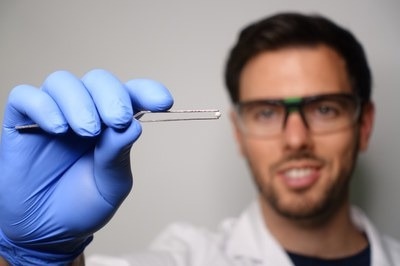Catalysts are known to be of extreme significance for the production of energy storage with hydrogen and chemicals.
 Catalyst pellet for hydrogen release. Image Credit: — HI ERN / Thomas Solymosi.
Catalyst pellet for hydrogen release. Image Credit: — HI ERN / Thomas Solymosi.
At the Helmholtz Institute Erlangen-Nürnberg for Renewable Energy (HI ERN) and Friedrich-Alexander-Universität Erlangen-Nürnberg (FAU), scientists have currently found out that the development of bubbles in the pores of a catalyst could be essential for its activity.
Their outcomes help to maximize catalyst materials for reactions in which gases have been developed from liquids, which play a vital role in a future green hydrogen economy.
Catalysts expedite chemical reactions in the absence of being used up by themselves. Several reactions in nature and industry only work due to their help.
For instance, catalysts are utilized in nearly 80% of all chemical production processes and play a vital role in technologies for the chemical storage of hydrogen.
In most cases, alleged heterogeneous catalysts were involved, which are in a diverse aggregate state compared to the real reaction partners. Especially solid, porous catalysts are essential here, as they could be isolated very well from gaseous or liquid reaction products.
Scientists at HI ERN and FAU have currently discovered: The productivity of this kind of catalyst for gas generation reactions could be markedly raised if gas bubbles develop, especially in a simple manner in the catalyst pores.
This additional factor, which significantly determines the reaction rate, was previously unknown. Until now, it was assumed that the reaction rate was determined only by the chemical surface reaction or by the transport of molecules to the active centers of the catalyst,.
Dr Peter Wasserscheid, Professor and Director, Helmholtz Institute Erlangen-Nürnberg
Wasserscheid is a director of the branch of the Jülich Research Center and head of the Chair of Chemical Reaction Engineering at FAU.
Increasing Productivity by a Factor of 50
The breakthrough was made with the help of a reaction that could play a vital role in the transport of green hydrogen in the future. As a result, hydrogen has been stored and transported bound to a liquid carrier medium-in this case LOHC (“liquid organic hydrogen carrier”)-and later discharged from it.
The technology has been taken into account to be exceedingly safe and simple to handle. The quicker hydrogen could be liberated from the carrier medium with the help of a catalyst, the more powerful and compact that technology could be utilized.
The scientists at FAU and HI ERN displayed that around 50 times more hydrogen is liberated from the carrier medium per unit of time under the same conditions when the development of gas bubbles in the pores of the catalyst has been induced in the process.
The cause for the huge variation:
Normally, the system produces only dissolved hydrogen during catalytic hydrogen release. Saturation then quickly sets in in the liquid phase around the active centers of the catalyst.
Dr Peter Wasserscheid, Professor and Director, Helmholtz Institute Erlangen-Nürnberg
The bubbles present in the catalyst pores, at the same time, act like small pumps. They help to eliminate the released hydrogen.
Once a bubble has formed in a catalyst pore, the growing bubble collects the formed hydrogen. When the bubble then detaches into the surrounding liquid, the loaded hydrogen carrier flows back into the pore and the process starts all over again.
Dr Peter Wasserscheid, Professor and Director, Helmholtz Institute Erlangen-Nürnberg
The bubbles’ formation, called nucleation, could also be induced artificially, for instance, by chemically altering the catalyst surface or by a mechanical stimulus.
The outcomes provide insights into the new light on performance-limiting factors in heterogeneous catalysis, which are of very high significance, particularly for the green hydrogen economy of the future.
The study outcomes were achieved in partnership between the teams of Professors Jens Harting, Matthias Thommes, Nicolas Vogel, and Peter Wasserscheid in the DFG Collaborative Research Program 1452 “Catalysis at liquid interfaces” and have just been published in the prestigious journal Science Advances.
H₂ bubble formation by mechanical stimulus
Experiment: Activation of H₂ bubble formation in catalyst pellets by light pressing with a metal rod (Length1:19 min.) Video Credit: Julich Forschungzentrum.
Journal Reference:
Solymosi, T., et al. (2022) Nucleation as a rate-determining step in catalytic gas generation reactions from liquid phase systems. Science Advances. doi: doi.org/10.1126/sciadv.ade3262.